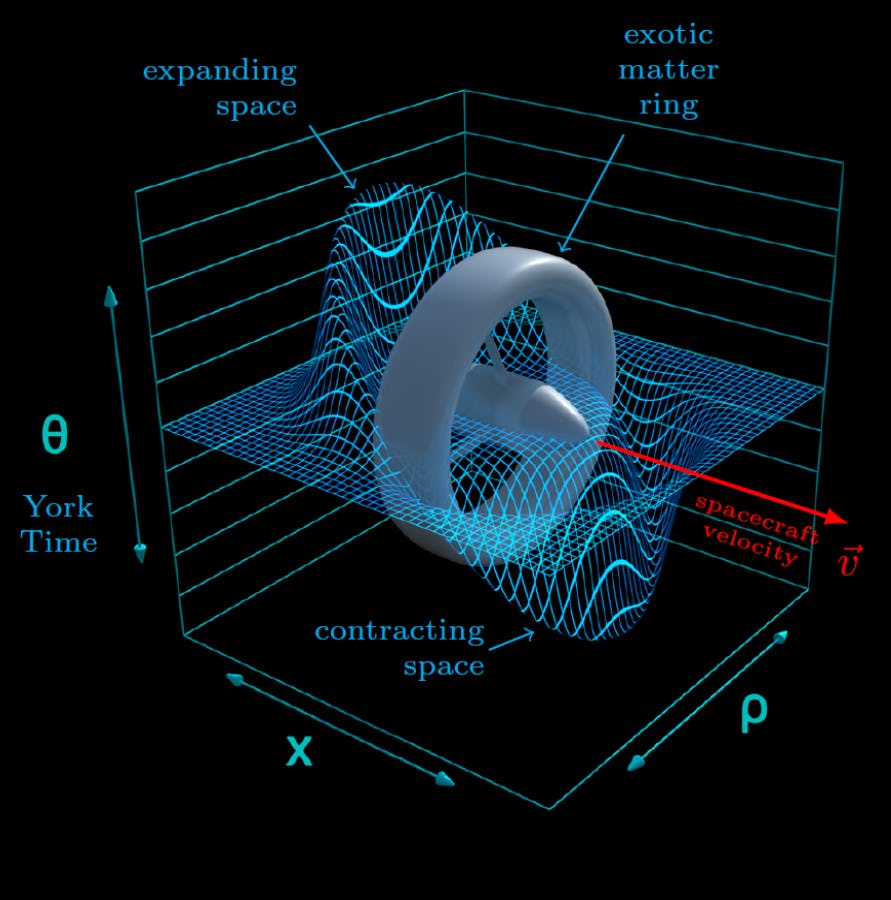
“To boldly go where no man has gone before.” With a single phrase, Star Trek changed science fiction history and inspired a whole generation of physicists using the concept of the warp drive.
The movie Star Trek: First Contact explores the genesis of this science fiction concept by introducing Zefram Cochrane, the inventor of the warp drive, which allows starships to travel faster than the speed of light by warping spacetime. But can you really traverse massive distances of space in a matter of minutes or hours?
As it turns out, the basic idea outlined within Star Trek might not be impossible according to physics — even if the finer details still elude us. Let’s dive in. Spoilers ahead for Star Trek: First Contact.
“The idea that is intimated through the story of Star Trek, that's a very possible idea — the idea of a space warp,” Sonny White, director of Advanced Research and Development at the Limitless Space Institute, tells Inverse.
Reel Science is an Inverse series that reveals the real (and fake) science behind your favorite movies and TV.
Can you travel faster than the speed of light?

The premise of Star Trek: First Contact — and the entire Star Trek enterprise — rests on an eccentric inventor, Zefram Cochrane, whom the crew of the USS Enterprise-E meets. They convince Cochrane to stick to his plan of testing out the warp drive at exactly the same time an advanced alien species — the Vulcans — will be passing by Earth.
“Doctor: tomorrow morning, when they detect the warp signature from your ship and realize humans have to discovered how to travel faster than light, they decide to alter their course,” Commander William Riker, the first officer of the Enterprise, tells Cochrane.
The warp drive’s faster-than-light speed is, therefore, responsible for humanity’s first contact with aliens, helping us realize we are not alone in the cosmos. But there’s just one problem. The law of general relativity — one of the guiding principles of physics — has an important rule.
“I call it the Eleventh Commandment in physics, Thou shalt not exceed the speed of light,” White says.
Richard Muller, an emeritus professor of physics at the University of California, Berkeley, views the question of faster-than-the-speed-of-light travel somewhat differently. He says you definitely cannot travel at the speed of light per physics.
“But the concept they could go from under the speed of light to over the speed of light by some sort of quantum leap is not really ruled out,” Muller says. Mechanisms like a quantum leap, a wormhole, or, yes, a warp drive, could create a loophole to bypass this rule of physics.
White maintains you cannot travel faster than the speed of light, but says you could theoretically devise a system that generates an effective velocity that appears to be faster than the speed of light. He uses the conveyor belt walkways you see in airports as an analogy. Even though you’re still walking the same speed that you were on a normal surface, you appear to be walking faster on the beltway to an outside viewer.
“If we can construct a starship with a propulsion system that decreases space in front of it and expands space behind it. This ship could cross enormous distances effectively faster than the speed of light,” White explains in a video for the Limitless Space Institute.
Are warp bubbles real?

Both White and Muller focus on the concept of contracting and expanding spacetime — call it a space warp or a warp bubble — as central to the starship’s ability to cover vast amounts of distances in a short period of time. This concept is known as the fictional “warp drive” in the Star Trek universe.
“Lieutenant Hawk: set a course for Earth. Maximum warp,” Captain Picard tells his officer, who responds that it will take merely three hours and 25 minutes to reach our planet using the warp drive.
Physicist Miguel Alcubierre was reportedly inspired by Star Trek to devise his own idea of a warp drive, which led to the Alcubierre metric in the 1990s. It’s the idea that a starship could achieve effective or apparent velocity faster than the speed of light by contracting space in front of the ship and expanding space behind it.
Muller likens it to traveling through a mountain instead of traveling around it, thereby shortening your travel time.
“What I liked in Star Trek is that the term warp drive, to me, suggests that they have a way of bending space so that they can take a shortcut from one place to another,” Muller expands.
In a 2021 paper, White proposed a structure that theoretically makes it possible to create a nanoscale warp bubble.
But don’t get too excited — we are still leaps and bounds away from being able to warp spacetime and send a starship through it. It would be a static warp bubble, so it wouldn’t go anywhere.
“We can propose a real structure now that is predicted to manifest a real nanoscale warp bubble. The next question is, how do we do that in a way that we can measure that in a lab?” White adds.
Is Star Trek’s physics plausible?

Muller says that if you can find some way to warp space — beyond gravity — then you could travel like in Star Trek. He believes the physics of the show is sound, given that they live in a world with boundless negative energy provided by anti-matter drives to power interstellar travel.
“I haven't seen anything in [Star Trek] that violates anything that I can't explain,” Muller says.
White calls Star Trek a “romantic encapsulation” of scientific concepts, but says it’s true that a space warp would allow somebody to cover very large distances in a very short time. We have built mathematical models to codify numerically what it would take to travel vast distances of space like the USS Enterprise. We just can’t build the systems it would take to travel that distance — yet.
“So, the ideas that are expressed in Star Trek may indeed be possible at some point,” White says.
Star Trek: First Contact is streaming now on HBO Max.







